A Trip to the North

May 20, 07
The Grand River as it flows through Cambridge (old Galt,) looks like an aged postcard, but familiarity seldom breeds content, and we decided to drive as far North as one can in Eastern Canada (while staying on pavement.)

We had planned to make it to Chisasibi for the summer solstice on June 21, but stuff happens and changes become necessary. We loaded the Toyota, bid adieu to the cats, and left Cambridge (a city about an hour west of Toronto) by 3:40, heading East on 401, then North on 410.
North of Toronto, the limestone of the escarpment gives way to the granite of the Canadian Shield somewhere around Lake Simcoe. Gentle rolling hills become sharper and harder, reminiscent of the American Rockies, but without the altitude. We swung into Barrie and found a nice, upscale town with many new high rise condos along the lake shore - the place looks very livable at this time of year, but the locals say that the snow fall is extreme.
We passed a huge number of small lakes (large ponds?), with fir trees down to the waters edge. Pictures don't do the area justice as you loose the sheer volume of these features. A canoe and a picnic basket could be put to good use almost anywhere in this area. The Muskokas are the heart of cottage country with huge old mansions and tiny one room cabins scattered everywhere. I think prices are high in this area, but the beauty, coupled with proximity to Toronto, certainly justifies the cost.
.

Near dusk we pulled in to North Bay, the downtown area looked seedy, but construction was under way on a number of buildings that may spruce things up.

Motel row is south of town and seems to provide lodging for any pocket book. The Glen Garry Motel was a small, 50's looking place next to lake Nipising with period furnishing. Everything was very clean, quiet, and the bed was good. A great value at under $60.


We ate at the Churchill, ostentatious, but not the best choice in either of our opinions, then watched the sunset from Sunset Park, a granite peninsula sticking into Lake Nippising with some great views. A number of older couples walked to the park to watch the setting sun which seemed like a nice ritual.

The ubiquitous aluminum skiff, with a couple of Nipissing fishermen heading back to shore.

On the east side of the park a number of people were fishing from the shore. A family man caught a large walleye while I was there, had his son hold it for a few pictures then tossed it back into the lake - neat stuff!
May 21, 07
Looks like about 600 km to Matagami going through Temiscaming. I'd worked in Temiscaming for a very short period 40 years ago and have fond memories.
Today Temiscaming is much smaller than I remembered it, but still as picturesque. I couldn't really find a "down town" area, but a gal at a convenience store directed us to where the lodge had been years ago. It's now company headquarters for a pulp company, but years ago it was a place for local beauties to be wined and dined by wealthy hunters and fishermen that flew in, anchored their float planes in the Ottawa River and made their way to the lodge. French is normally spoken but almost everyone speaks some English - It was here that I heard Hoss Cartwright speaking French many years ago on one of the two TV stations then available (one in English and one in French.) We found some beautiful vistas near a small dam, and some large, ornate fountains that seemed a little out of place.


North of town we were surprised by the number of farms we saw. It seemed that we would have been too far north for farming to be viable, and before we reached Matagami the farming had died out.
The farming country gives way to lakeside vistas before changing again into boreal forest.

.

The further north we went the more black spruce we saw. These are strange, with a plume on top and impossibly thin trunks, a tree as tall as a telephone pole is only about one third the diameter, in some ways they are reminiscent of palm trees with skinny trunks, heavy tops and little in between. I'd seen them in Newfoundland and Labrador and thought they had grown that way due to the bad soil conditions. Oh well.
Vast areas had been burned out in one forest fire or another, but natural regrowth is persistent.
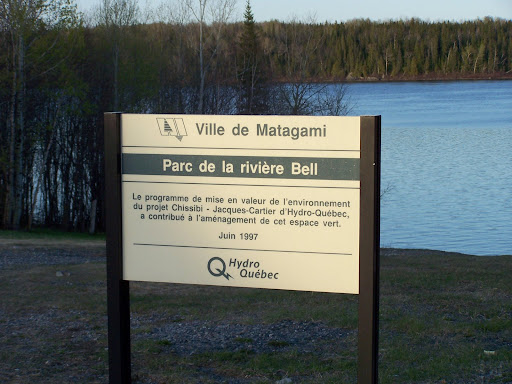 Matagami is the end of the public road - from here on Hydro Quebec owns the highway but allows anyone to use it. Matagami was built as a company town in 1962 and after the initial buildup has lost population ever since. Buildings originally set up as quadraplexes that have been converted to one or two family units seem to be the norm. Located on the Bell River this would be a great place for a canoe. The Matagami Motel appears to be the best of the three available - the rooms are not cheap, but furnishings were good and food in the rather cafeteria appearing restaurant was fabulous! I had walleye almondine with "hand vine" heads in the veggies, these may be related to the "fiddle heads" held in high esteem in Southern Ontario. On our way back I had a French duck dish, not just the best meal of this trip, the best in a very long time.
Matagami is the end of the public road - from here on Hydro Quebec owns the highway but allows anyone to use it. Matagami was built as a company town in 1962 and after the initial buildup has lost population ever since. Buildings originally set up as quadraplexes that have been converted to one or two family units seem to be the norm. Located on the Bell River this would be a great place for a canoe. The Matagami Motel appears to be the best of the three available - the rooms are not cheap, but furnishings were good and food in the rather cafeteria appearing restaurant was fabulous! I had walleye almondine with "hand vine" heads in the veggies, these may be related to the "fiddle heads" held in high esteem in Southern Ontario. On our way back I had a French duck dish, not just the best meal of this trip, the best in a very long time.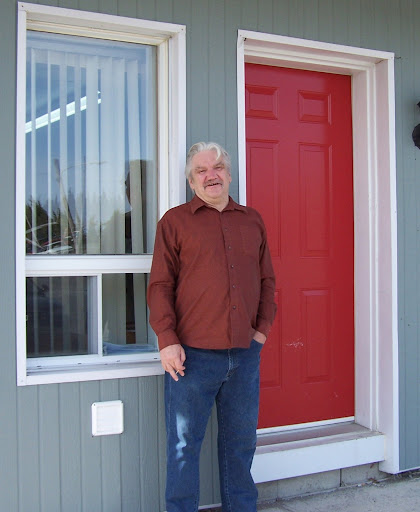
The rooms at the motel have raised doors to cope with the winter snow buildup. It's a little reminiscent of the bulkhead doors on a boat.
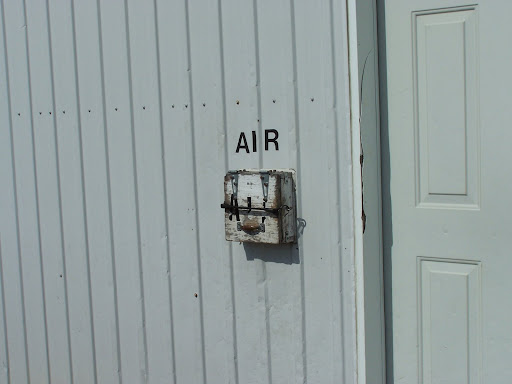
Another strange thing was the air hose at the gas station. It retreated behind a latched door and had to be retrieved by opening the latch, holding the door up with one hand while retrieving the hose from about a foot back. I can't imagine what kind of animal would be so enamoured of air hose rubber, but whatever it is it must be smart and persistent.
May 22, 07
Had breakfast at the motel, topped up the tank and headed toward Chisasibi!!
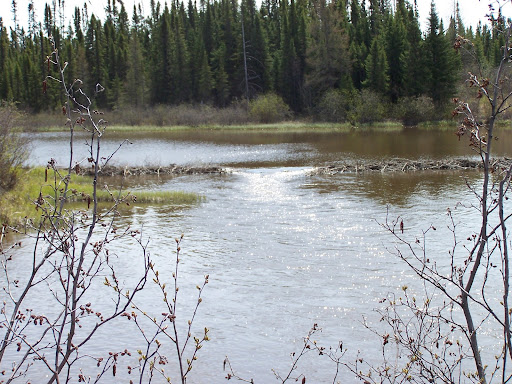
We checked in at the beginning of the road - I think it's so they'll know if anyone doesn't get back in a reasonable time. For the next 600 km there is only one business, a truck stop 381 km north of here. No motels, no restaurants, no gas stations, no rest areas, no homes, (except for beaver lodges.)
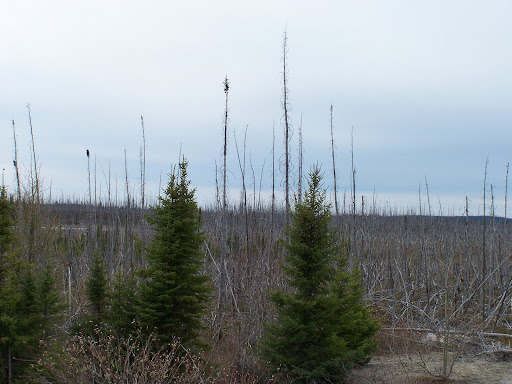
There are a very few dirt roads intersecting our highway, most heading to remote Cree villages on the shores of James Bay, but for most of the day it's Northern Boreal Forest, slowly morphing into Taiga.
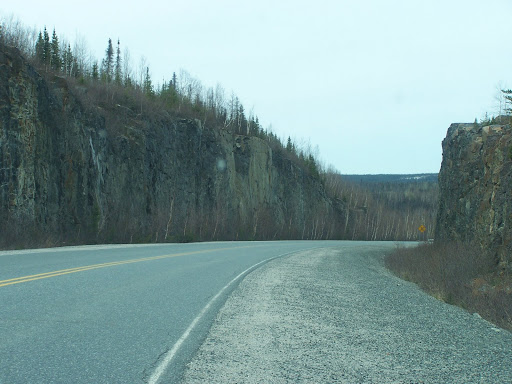 The road is different than any I've been on, it is a decent two lane paved road that goes 600 kilometers with only one commercial stop along the way. We passed 1 auto, 6 trucks and 13 pickup/vans along the way. At the bridge over the Rupert river we met a construction worker building a dam higher on the river, but that was it for traffic in our direction.
The road is different than any I've been on, it is a decent two lane paved road that goes 600 kilometers with only one commercial stop along the way. We passed 1 auto, 6 trucks and 13 pickup/vans along the way. At the bridge over the Rupert river we met a construction worker building a dam higher on the river, but that was it for traffic in our direction.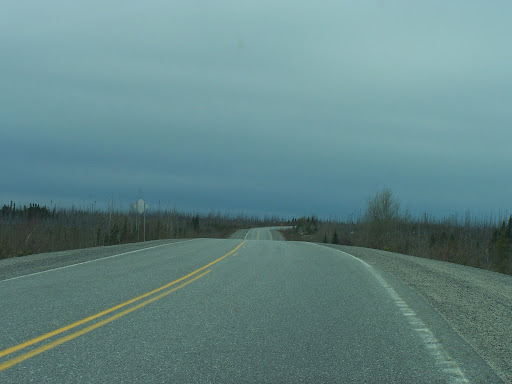
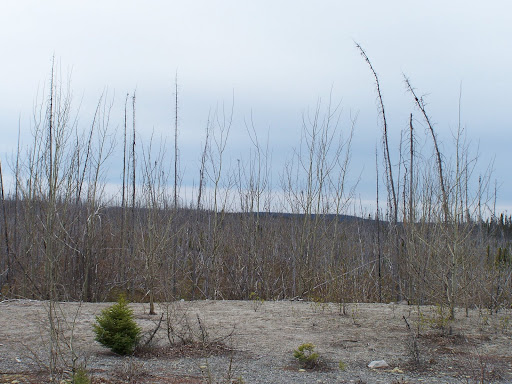 I've been on roads with no more traffic than this one, but they were all part of a grid system. From here going north the next road would be in Russia, to the east in Ireland, to the west Manitoba. I've driven the "Loneliest Highway" in Nevada, the endless Trans Canadian highway through the prairie, and the only paved road in Labrador, but on none of these did I feel so isolated.
I've been on roads with no more traffic than this one, but they were all part of a grid system. From here going north the next road would be in Russia, to the east in Ireland, to the west Manitoba. I've driven the "Loneliest Highway" in Nevada, the endless Trans Canadian highway through the prairie, and the only paved road in Labrador, but on none of these did I feel so isolated.Cell phones are not supported, so SOS phones are in place every 90km or so - they are ordinary appearing phone booths that take phone cards or change. Beside the phone is a small building housing the generator, then a few telephone poles running up a hill to a microwave tower. Another strange thing about the road that isn't noticed at first is that there are no power or phone lines visible. When we came to a stretch that did have them they looked terribly out of place.
 The Rupert river will be shut down some time next month, it's a huge, swift running river that reminds one of the Niagara, but faster and with more water.
The Rupert river will be shut down some time next month, it's a huge, swift running river that reminds one of the Niagara, but faster and with more water.

The noise as it smashed over the rapids is so strong and so deep that it seemed to vibrate everything.
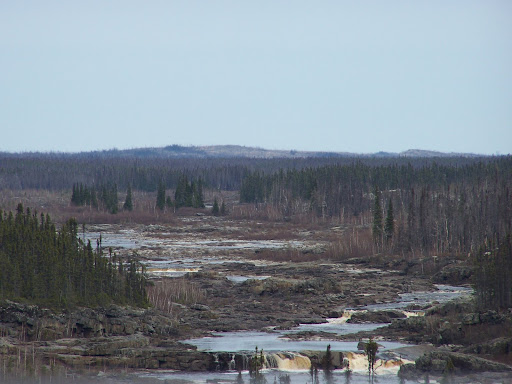
Later at Chisasibi we were told that the Eastman River had been even bigger, and that a huge mermaid with evil intentions used to live in the mist of the big rapids just west of the road. Monkey Island is where a much smaller race of humanoids had once lived acording to Cree lore.

The road is on a glacial moraine, so gravel and sand (even sand dunes) make up most of the terrain. Where rivers have cut deep channels the underlying granite of the Canadian Shield protrudes, but the strangest thing to me was the "caribou lichen" that coated the forest floor as we got further north. It's light, slightly green coloring lightens and brightens the forest giving the same kind of clean visage that fresh snow imparts. It's two or three inches thick and about the consistency of a cheap sponge. I brought a small amount back to Toronto and most thought it resembled some kind of coral. My digital camera bounced and sustained no damage when I dropped in onto the lichen. Sitting or lying on this lichen is a pleasant experience, softer than a thick grass lawn, firmer than a firm mattress. The piece I brought home is in a baggie and seems to be surviving my brown thumb - amazing stuff.
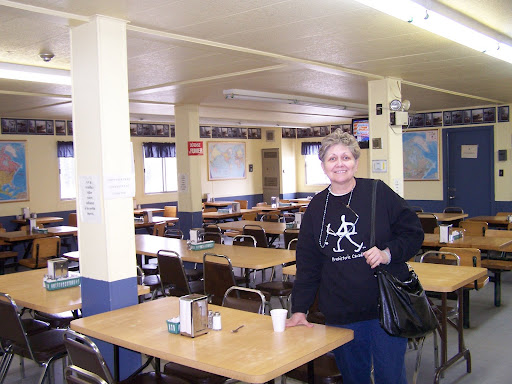
.
 The station at Km 381 was disappointing, I'm not sure what I was expecting, but this was not it. The signage at the turnoff was unreadable, a huge gravel parking area with trailer bunk houses, older truck repair facilities, one set of gas/diesel pumps, a helicopter on it's pad and a company style cafeteria. We filled up on gas, passed on the food and headed on to Radison.
The station at Km 381 was disappointing, I'm not sure what I was expecting, but this was not it. The signage at the turnoff was unreadable, a huge gravel parking area with trailer bunk houses, older truck repair facilities, one set of gas/diesel pumps, a helicopter on it's pad and a company style cafeteria. We filled up on gas, passed on the food and headed on to Radison.
Near Radison our Garmin GPS software was not aware of the road system, which was OK, the signs were good and it's hard to get lost when nothing else is around.
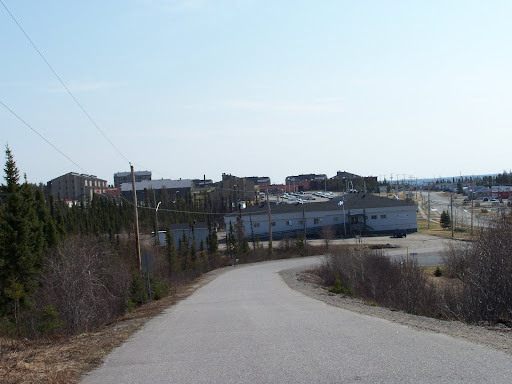
Radison was built by Hydro Quebec and looks a lot more like a large trailer park than a small town. We stayed at the Radison Hotel, by far the best in town ,but pricey. The restaurant was closed all the time we were there so we ate down the road where serving great meals was not a high priority. Carole found a great gift shop with lots of Cree and Inuit crafts.
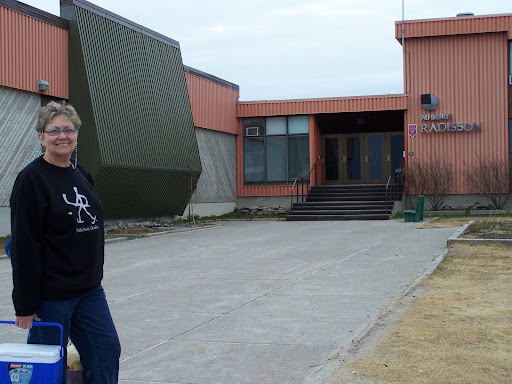
I purchased a small Cree tamarisk goose decoy. I'd read some where that they leave the head hollow so that snow reflecting back through the hole will look like the reflection from an eye. These are very well made and apparently were used as is, unlike the tule duck decoys from the American south west which were covered with the skin and feathers from a duck.
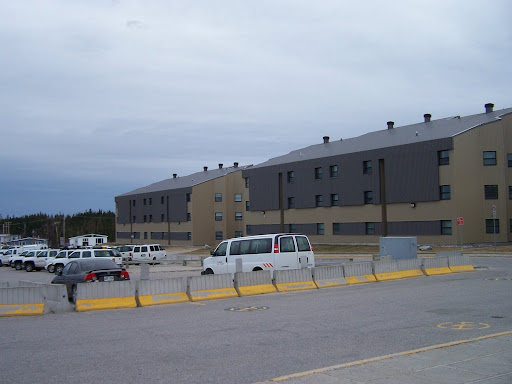
Quebec Hydro has provided 110 volts to each of the parking spaces at the hotel. If we ever get a plug in vehicle we'll have to make a return trip. :)
May 23,07
Finally we head straight to Chisasibi!
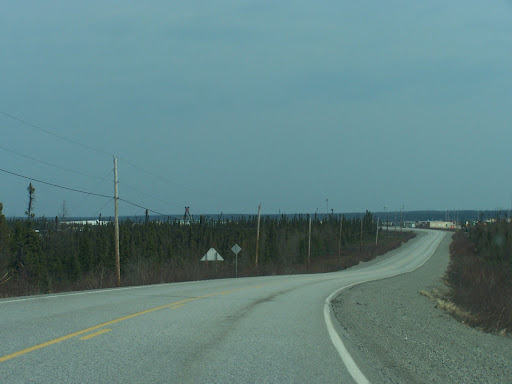
I'd read on the internet that the Cree living here speak Cree as their first language, and either English or French as a "working" language. My guess is that everyone speaks Cree and English and a fair number also speak French and or Inuit.
The towns municipal buildings are build around the town's main fire hydrant, a town plan dating back to the town at Ft. George ,where the only safe water came from the Hudson's Bay fire hydrant, and most wanted to live close to the water source.
Town buildings were in poor shape - broken windows, graffiti, damaged trim - I never found out what the problem was, but most don't treat common areas this way. The housing looked nice and well kept and everyone was helpful and friendly, stopping what they were doing to show us where to go and in one case opening a small souvenir shop just for Carole.
Then we met Sherman.
Sherman is a one man welcoming committee, chamber of commerce, travel agent, guide and, before your trip is done, friend.
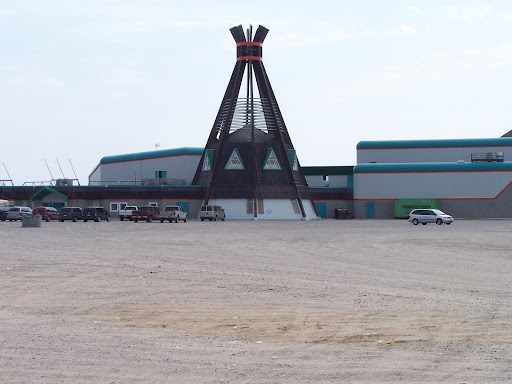
I'd heard others sing his praise on the internet, and when I asked a young man if he knew where Sherman's office was he dropped what he was doing and lead us to a smallish office in the municipal building shaped like a tepee.
After introductions (everyone up here wants to shake hands and exchange names) we explained that we were not interested in fishing or hunting, but that we did want to visit the old island village of Ft George, wanted to see James Bay and hoped to ride in a freight canoe. Sherman advised that a busload of kids from Quebec City were headed to the island in a short time and pointed out their white bus with instructions to follow them when they were done with their lunch. We drove around the village for a little while before heading west on the road that we were sure the bus would have to take.



Carole saw the bus turn off before it got to us, so we gave chase over some very poor gravel roads. when they stopped their teacher asked if I was Sherman so I told her I wasn't but that he had said it would be OK if we tagged along. They had stopped at the shore of James Bay where hundreds of huge canvas over wood freight canoes were resting upside down in the sand. Again everyone shook hands and exchanged names, the only name I remember was Clarence a teen aged Cree who took great pride in being able to point out many ingenious methods traditionally used to survive this far north.

Like all the Cree we met Clarence seemed glad to be conversing with people from other cultures, was concerned that we should understand more of his culture, and was a warm friendly person. His hope for the future was to learn more of the traditional lore and be able to help preserve it as a story teller.
 The kids from Quebec city (almost as far from home as ourselves) were spending the night out in one of the hunting camps that are scattered through the area. I guessed that they were about the age of high school seniors but I'm terrible at guessing ages. They all spoke French with some English while the teacher was fully bi-lingual. I felt a little out of place until we headed off to the river and the teachers car wouldn't start. My jumper cables got her going and after that I felt I had as much right to be in the group as anyone.
The kids from Quebec city (almost as far from home as ourselves) were spending the night out in one of the hunting camps that are scattered through the area. I guessed that they were about the age of high school seniors but I'm terrible at guessing ages. They all spoke French with some English while the teacher was fully bi-lingual. I felt a little out of place until we headed off to the river and the teachers car wouldn't start. My jumper cables got her going and after that I felt I had as much right to be in the group as anyone.
Sherman joined us as we prepared to cross the Grand River by freight canoe. He and Robby powered up the river, leaped from the canoe in hip waders and started loading passengers.

 The canoe was huge, I'd guess about 30 feet by 6 feet with a prow sticking 4 ft out of the water and a flat transom holding a 60 horse Honda outboard. I had no idea that wood/canvas canoes were built anywhere except as toys for rich guys who appreciate old things. These were built as deep water craft for moving through the islands of Hudsons Bay as well as the rivers feeding it. From the number of them in the area it looked as if every family probably
The canoe was huge, I'd guess about 30 feet by 6 feet with a prow sticking 4 ft out of the water and a flat transom holding a 60 horse Honda outboard. I had no idea that wood/canvas canoes were built anywhere except as toys for rich guys who appreciate old things. These were built as deep water craft for moving through the islands of Hudsons Bay as well as the rivers feeding it. From the number of them in the area it looked as if every family probablyowned one, just as every family had
a truck or van.
The Cree here built freight canoes for the Hudson's Bay Company and feel
 as much at home in one as we feel in a car. In Hawaii I rode in an outrigger with an old man who had grown up using a canoe as his primary means of transportation. He and the Cree of James Bay both seem to find a sense of elation being on the water in traditional watercraft, although the Hawaiian did jump overboard when he thought a wave was about to capsize us.
as much at home in one as we feel in a car. In Hawaii I rode in an outrigger with an old man who had grown up using a canoe as his primary means of transportation. He and the Cree of James Bay both seem to find a sense of elation being on the water in traditional watercraft, although the Hawaiian did jump overboard when he thought a wave was about to capsize us.
After ferrying us across to Fort George Island, Sherman showed us the old church where he had been married (with an old reed organ that still works,) the cemetery where many of his family were buried, Hudson's Bay Company warehouses, the traditional chief's two story home and much much more.






Carole wore herself out and Sherman walked her all the way back to the ferrying place. When he returned I'd doffed my heavy parka and he didn't recognize me at first. He asked the group where the "elder" was - I've never been called an elder before, it sounds a whole lot better than old fart.




We left the island and decided to go back to Radison as we'd been unable to get a room at the hotel in Chisasibi. Next time we'll book ahead.
I went to the grocery store to pick up some goodies and ran into a few people drawn by my Las Vegas license plates. Apparently some Americans fly in in September to hunt Caribou, and while a few, mainly from New York State (where the electricity goes) have made the drive, none remembered anyone from Nevada showing up before. Bill and Helen waited until I was done with my shopping to introduce themselves. They were an older Cree couple from Chisasibi who had never gone as far as Matagami. They shook my hand, introduced themselves and told me a little about their life.It's hard to explain what is so different about the Cree culture in the far north. They are friendly, gentle, kind and caring. They are a hunting culture, not a warrior culture, not agriculturalists. Warriors make war, farmers want more land, a hunter wants friends to assist with the kill. If most hunter cultures tend to be like the Chisasibi Cree, I want to spend more time around them.
May 24, 07
There is a small museum in the same building as the Radison Hotel which we went through although everything is in French which neither of us understand. The same is true for all the historic markers along the road (actually they are in French and Cree). We obtained an English cheat sheet from the museum guy and mentioned that a similar one for those driving up the road would cost very little and be really helpful for those of us that speak only one language (ie Americans). He asked if we planned to see the Hydro project, but since we hadn't called ahead an English tour wouldn't be available for a few days. We told him we were heading back in an hour or two and would have to pass this time.
As we left the building a local cop wanted to meet the people from Nevada, again a handshake and the exchange of first names. While talking to the cop a couple of French speaking fliers came by and the museum guy rushed out to offer us a quick, free,one hour tour of the dam. Our new French friends came along and we were taken to an unbelievably huge dirt fill dam. The pilots spoke fair English but professed confusion as to why two very different birds went by the same name, while the plural was so different from the singular. (goose and geese, wild and farm)
The fliers told us that everyone in Quebec knows of this huge project (17 MW/day as opposed to 2MW/day for Boulder Dam in Nevada,) and that power was very cheap in Quebec since the Province owned the utility.
We gassed up, checked tires and fluids and headed back down the road. This time we skipped 381 and blasted on through to Matagami, almost running out of gas in the process. We again spent the night at the Matagami Motel, and again sampled their fabulous cuisine.
May 25, 07
We decided to go further west on our return trip, heading for the North Shore of Lake Tamiskaming. Amos is the first real city coming in from the north and after a few days away from it, interacting again with traffic can add excitement to the day.
We swung west at Amos and went through some of the most beautiful country I've ever seen. The yuppies haven't discovered it yet, and may be put off by the primarily French language usage. At one point, while we were slightly lost, we passed a huge stone monastery that looked like it belonged in a different century but were never able to locate it on a map.
In the late afternoon we drove through Kirkland Lake which was a little disappointing. The road going west into the town was beautiful with at least two mountain peaks resembling the Materhorn a formation due to mountain glaciation and referred to as a horn. Forests and small lakes were everywhere until we arrived at Kirkland Lake, oh well.
We followed the road around and headed for Temiskaming Shores, at Haileybury we found another 50's Motel - this one across the road from the yachting facilities with a million dollar view. Sail boats must have a mast that can be unstepped as well as a removable or swing keel to use the facility's - my kind of boats!!
A small park up the hill has huge samples of local rocks and minerals connected to a school of mining. I highly recommend the motel, the town and the area. The yuppies haven't arrived yet, housing is somewhere between reasonable and cheap, the locals are bright and friendly and the scenery has to be seen to be believed.
May 26, 07
Today we head home. We miss the cats.
Everyone had recommended Cobalt for the old buildings, so we headed in that direction leaving town. It was well worth the detour. At one time an engineer had developed a system there that produced huge volumes of compressed air by dropping water down a vertical tube, drawing the compressed air from the top of a horizontal tube at the bottom before bringing the water back to almost the same elevation in another vertical pipe set just below the top of the horizontal one. The rig produced huge amounts of compressed air for decades until a fire finally destroyed the valving building. Building a model just to see how well it worked would realy be a kick.
Heading south we stopped at Gravenhurst. If you haven't been there go. The old laker steam boats have to be seen to be believed. We were too late to take in the new museum of boating but will come back to see it.
The suburbs are growing out from Toronto in all directions like cancerous lobes. I've seen this in Southern California, Arizona and Nevada - it's ugly, it never works and it hurts me to see it swallowing up the beautiful towns and villages in Southern Ontario.
Got home around dusk, unloaded the car and reintroduced ourselves to the cats.
Recapping the trip:
We ran 1014 miles from Cambridge to Radison, but there is no break for the last 360 miles. A 654 mile day is too long for vacation driving (never after dark is you're traveling to see stuff,) so leave three easy days for the drive up, and two days to come back down (507 miles a day is do-able, if you're in a rush.
Get gas at KM381 going both ways, I was under an eighth of a tank pulling into Matagami.
If you've got a canoe, take it and double the time allowed :)
Calling ahead isn't needed except for the Chisasibi Hotel and the Hydro Quebec Tour
Labels: Cambridge, Chisasibi, Freight Canoe, Hydro Quebec, James Bay, Matagami, North Quebec, road trip, Rupert River, vacation


1 Comments:
Looks like a lot of fun andi love those freighter canoe pictures.
Post a Comment
Subscribe to Post Comments [Atom]
<< Home